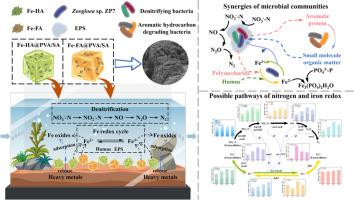Bioremediation of oligotrophic waters by iron-humus-containing bio-immobilized materials: Performance and possible mechanisms
IF 11.4
1区 环境科学与生态学
Q1 ENGINEERING, ENVIRONMENTAL
引用次数: 0
Abstract
The combined pollution and oligotrophic characteristics of surface water led to poor self-purification capacity of water bodies. In this study, humic acid (HA) and fulvic acid (FA) were used to promote the denitrification process of strain Zoogloea sp. ZP7. Subsequently, iron and different humus (HA and FA) composites were encapsulated by polyvinyl alcohol (PVA) and sodium alginate (SA) to prepare two biological immobilization (BI) carriers Fe-HA@PVA/SA (FHB) and Fe-FA@PVA/SA (FFB), which immobilized strain ZP7. The BI materials were added to the water remediation system model and operated for three stages (synthetic wastewater, actual polluted surface water, sediment-contaminated surface water) for 48 days. The results showed that FHB (FFB) could remove up to 89.7 % (88.6 %), 90.5 % (89.5 %), 82.2 % (81.5 %), and 90.4 % (80.8 %) of total nitrogen, nitrate, CODMn, and phosphate from the actual polluted surface water within 16 days of stage II. In addition, the incorporation of FHB and FFB was effective in controlling the release of organic matter and heavy metals from the sediments. Microbial community analysis showed that Zoogloea became the dominant species in actual water bodies. KEGG database analysis illustrated that the expression of genes related to denitrification and iron redox cycle was enhanced. This work provides a novel approach into the in-situ bioremediation of actual nutrient-poor water bodies.


含铁胡麻生物固定材料对低营养水体的生物修复:性能和可能的机制
地表水的污染和低营养特性导致水体自净能力差。本研究利用腐殖酸(HA)和富里酸(FA)促进 Zoogloea sp.随后,用聚乙烯醇(PVA)和海藻酸钠(SA)包裹铁和不同腐殖质(HA 和 FA)的复合材料,制备出固定菌株 ZP7 的两种生物固定化(BI)载体 Fe-HA@PVA/SA (FHB) 和 Fe-FA@PVA/SA (FFB)。将 BI 材料添加到水污染修复系统模型中,在三个阶段(合成废水、实际污染地表水、沉积物污染地表水)运行 48 天。结果表明,在第二阶段的 16 天内,FHB(FFB)对实际污染地表水中的总氮、硝酸盐、CODMn 和磷酸盐的去除率分别高达 89.7%(88.6%)、90.5%(89.5%)、82.2%(81.5%)和 90.4%(80.8%)。此外,添加 FHB 和 FFB 还能有效控制沉积物中有机物和重金属的释放。微生物群落分析表明,Zoogloea 成为实际水体中的优势物种。KEGG 数据库分析表明,与反硝化和铁氧化还原循环相关的基因表达得到了增强。这项工作为实际贫营养水体的原位生物修复提供了一种新方法。
本文章由计算机程序翻译,如有差异,请以英文原文为准。
求助全文
约1分钟内获得全文
求助全文
来源期刊

Water Research
环境科学-工程:环境
CiteScore
20.80
自引率
9.40%
发文量
1307
审稿时长
38 days
期刊介绍:
Water Research, along with its open access companion journal Water Research X, serves as a platform for publishing original research papers covering various aspects of the science and technology related to the anthropogenic water cycle, water quality, and its management worldwide. The audience targeted by the journal comprises biologists, chemical engineers, chemists, civil engineers, environmental engineers, limnologists, and microbiologists. The scope of the journal include:
•Treatment processes for water and wastewaters (municipal, agricultural, industrial, and on-site treatment), including resource recovery and residuals management;
•Urban hydrology including sewer systems, stormwater management, and green infrastructure;
•Drinking water treatment and distribution;
•Potable and non-potable water reuse;
•Sanitation, public health, and risk assessment;
•Anaerobic digestion, solid and hazardous waste management, including source characterization and the effects and control of leachates and gaseous emissions;
•Contaminants (chemical, microbial, anthropogenic particles such as nanoparticles or microplastics) and related water quality sensing, monitoring, fate, and assessment;
•Anthropogenic impacts on inland, tidal, coastal and urban waters, focusing on surface and ground waters, and point and non-point sources of pollution;
•Environmental restoration, linked to surface water, groundwater and groundwater remediation;
•Analysis of the interfaces between sediments and water, and between water and atmosphere, focusing specifically on anthropogenic impacts;
•Mathematical modelling, systems analysis, machine learning, and beneficial use of big data related to the anthropogenic water cycle;
•Socio-economic, policy, and regulations studies.
 求助内容:
求助内容: 应助结果提醒方式:
应助结果提醒方式:


